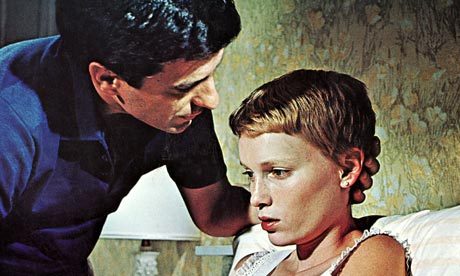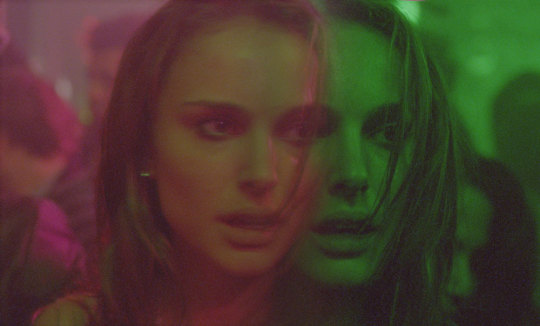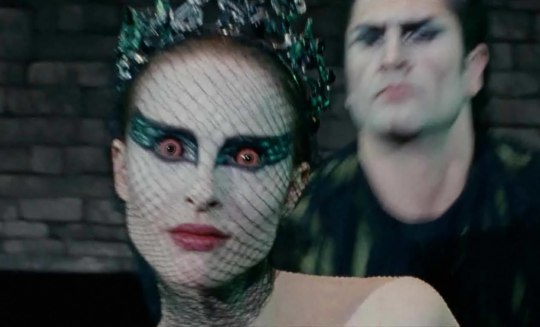The Terror Inside: ‘Rosemary’s Baby’ and ‘Black Swan’ By Alissa Wilkinson
By Yasmina Tawil

Baby girls get swaddled in pink, all sweetness and light, cooing little bundles of cotton candy. We sing them lullabies, play melodies on music boxes that cradle spinning ballerinas, nestle them between pillows and puffy stuffed rabbits. They grow. They pull on tiny pink tutus and soft pink canvas slippers and spin on their toes, glowing with joy. They grow. They have soft, cooing babies of their own.
Invert these saccharine trimmings of infancy and girlhood, though, and they grow sinister—a photonegative of innocence, a fleeing from the light. The opening titles of Rosemary’s Baby signal that such an inversion is happening before our eyes. While a pink script announces what you’re about to see in a self-consciously girlish manner, the eerie, wordless lullaby prickles your neck, and the camera’s perspective—hovering and descending over Manhattan—implies that a presence is about to alight, once it finds its mark: The Bramford, where Rosemary and her husband Guy are looking to rent an apartment and, soon, start a family.

I don’t know what it’s like to watch Rosemary’s Baby in a man’s body, but I know my body thrills sickeningly with primal terror. Mia Farrow’s Rosemary seems at first both scrappy and brave; she chooses the apartment, she initiates sex, she oversees renovations, she is confident and happy and plenty capable of standing up to others if she wants. She isn’t a model of twenty-first century feminism, but she’s no shrinking violet, either.
Yet her body, growing another being, undoes her. Impregnated without her own participation—either by Satan or by her husband, who cheerfully informs her the morning after that she’d passed out so he’d just gone ahead anyhow—she rapidly becomes merely a vessel, to be shaped and scolded by everyone else: Guy, doctors who tell her not to read, Minnie Castavet and her foul smoothies. And maybe Satan’s spawn, from the inside.
The longer this goes on, the more isolated Rosemary becomes. She’s not a prisoner in her apartment, but she seems like one, with her bouncing bundle of joy turned to tiny jailer inside. Guy roams freely, and so do the Castavets, who seem to be everywhere. But Rosemary is basically housebound, left alone in the domestic realm with her thoughts, her fears, her pains, and the sounds she hears through the walls. It’s a recipe for disaster.
In an essay included with the Criterion release of Rosemary’s Baby, Ira Levin explained the origin of his novel. “Having observed that the most suspenseful part of a horror story is before, not after, the horror appears,” Levin wrote, “I was struck one day by the thought … that a fetus could be an effective horror if the reader knew it was growing into something malignly different from the baby expected. Nine whole months of anticipation, with the horror inside the heroine!”

Levin—and others since him—suggest that what’s frightening about Rosemary’s Baby is that she is carrying the devil’s child. But that’s a red herring. You don’t know most of the time whether what’s happening to her is real or in her head, and it doesn’t matter. The horror comes from a perfectly natural bodily experience gone horribly wrong, something every woman fears. The final scene is more catharsis than climax; if it had concluded with a perfectly normal birth, and it turned out Rosemary was imagining things all along, the story of her nine months of agony might even have been more frightening. What’s scariest is that Rosemary’s physical and emotional transformation, her exhaustion and pain, her paranoia, seem equally plausible whether or not the Prince of Darkness has anything to do with it. Whatever is inside her gives others license to poke, prod, and pour tannis root down her throat; she is inhabited, and her womb’s tenant messes with those qualities most fundamental to her.
By the time she reaches that excruciating telephone booth scene, Rosemary has been hollowed out, reduced to a raving madwoman, talking to the being inside her. Watching her darting eyes and panicked receiver-clutching, I feel conflicted: I know she’s completely justified, but I judge her all the same. Can’t she just stop freaking out?
***

When Darren Aronofsky’s Black Swan was still just the subject of speculation—would it be a dance movie? a horror movie? high camp? —star Natalie Portman told an MTV News reporter that the film was “very unique in tone,” “a psychological thriller” she compared to Rosemary’s Baby. Aronofsky echoed the sentiment in interviews. Later, critics would compare Barbara Hershey’s performance as the ultimate ballet mom to Ruth Gordon’s as Minnie Castavets, all malignant concern and poisonous presence. Black Swan’s prologue starts not in the air but on the ground, with pink toe shoes tapping across the floor, as symbolic of delicate femininity as any curling typeface.
Portman’s Nina is as much an ingenue as Farrow’s Rosemary, though without Rosemary’s assertiveness. Nina is locked in her body, well-suited to portray the White Swan in Swan Lake not because she is particularly good, but because she lacks the imagination to be wicked. Nina is virginal and repressed; her childhood bedroom has been preserved well into her twenties, populated by stuffed animals and a ballerina music box, the soundtrack to her sleep. She spends her days at rehearsal and her nights stitching toe shoes at home with Mommy. And her transformation does not involve pregnancy.
Or does it? The film is purposely oblique about what is “actually” going on, and I don’t mean to suggest that Nina is carrying a fetus. But at least part of Aronofsky’s metaphor is that artistic creation is a process like birth. It requires a sacrifice of self, a transformation, passion akin to something sexual, to bring forth a new life. In Nina’s case, that life is clawing to get out (and has been a while, if the scratching episodes in the past to which her mother alludes are from the same cause). It breaks through her skin and her fingernails. It appears as a doppelganger—traditionally a harbinger of death—in the darkened windows of the subway, and eventually in Nina’s mirrors.

The identity of the “it” infesting Nina remains fluid, but “its” manifestations look like Rosemary’s. Nina loses weight. She feels pain. Her body is affected. She manifests a host of mental health issues, from schizophrenia to OCD. She lashes out at her mother. She becomes paranoid, sure that someone wants to steal her baby—her role as the Swan Queen, in this case—and is deliberately sabotaging her to that end. Everyone is a suspect. She can’t trust anyone. Once again, I’m in her mind, believing she is being pursued. And then I listen to her talk, and feel the same conflict. Can’t she just loosen up and have some fun?
***
One could understand both Rosemary’s Baby and Black Swan as following the contours of witch stories: an innocent woman is oppressed by men, and gains power only when she gives herself over to evil, whether that’s the devil or a Black Swan. Certainly that moment of surrender appears in both films—Nina’s in the dressing room, and Rosemary’s at the foot of the bassinet.
But the enduring horror of these movies is about more than oppression or evil. It’s worth noting that two films which parallel Black Swan in a number of ways—Birdman and Whiplash—treat the process of creation and artistic self-realization as violent, to be sure, but also empowering and freeing. In Birdman, our protagonist gains his wings and flies away. In Whiplash, he achieves perfection and demolishes his oppressor. The protagonists—both male—were immature, and now through their struggle something nobler has emerged, something powerful and elevated.
Not so for our women. Nina, too, achieves perfection—but then dies, having presumably been murdered by the occupying force finally exploding outward, her sanity having surrendered at last to her psychosis. Rosemary accepts her fate and signals surrender to the will of the coven. Watching Black Swan provokes the same response in my body as Rosemary’s Baby, maybe even stronger. My heart beats hard against my chest. My hands quiver; my arms feel as if I’ve just lifted and carried something heavy for a long time. My breath feels trapped inside my lungs. It’s painful.

If Rosemary’s Baby laces a common female experience with dread, so does Black Swan, a gothic horror tale for an age in which nearly every woman has battled something that’s taken up residence in her mind. I never dream about Whiplash, but I, and many women I speak to, have always dreamed of being inhabited by a force that isn’t me—something alien, something I can’t understand. Sometimes it’s a pregnancy, though in my dreams I never give birth. Sometimes it’s more sinister.
The uniquely terrifying implication of Rosemary’s Baby and Black Swan is of a force from inside turning you out, slowly sucking away whoever you thought you were and leaving you a shell you might not recognize. But in making you live alongside their protagonists’ experiences, the films perform an even darker trick: you recognize your own fears in them. Then you think: Can’t we just loosen up? Can’t we just stop freaking out? You recognize how it might look to the outside to live those fears in public. And you recognize yourself in them.


